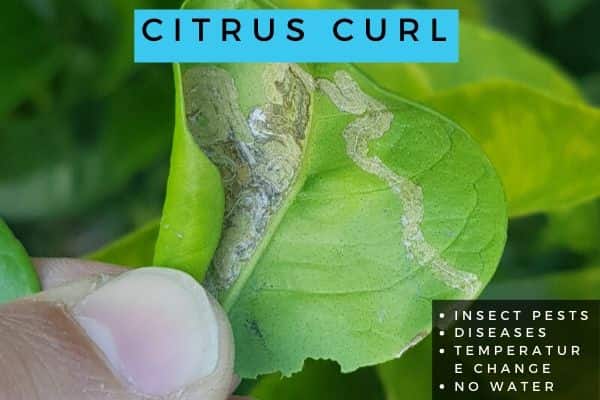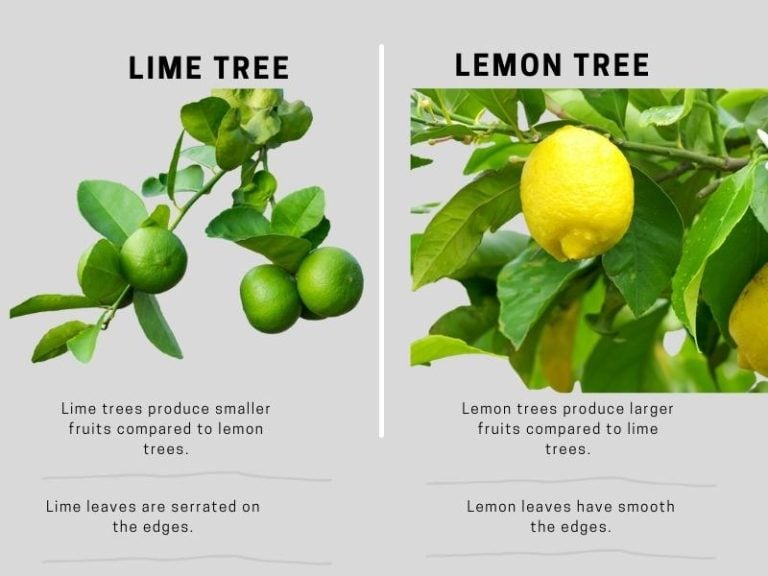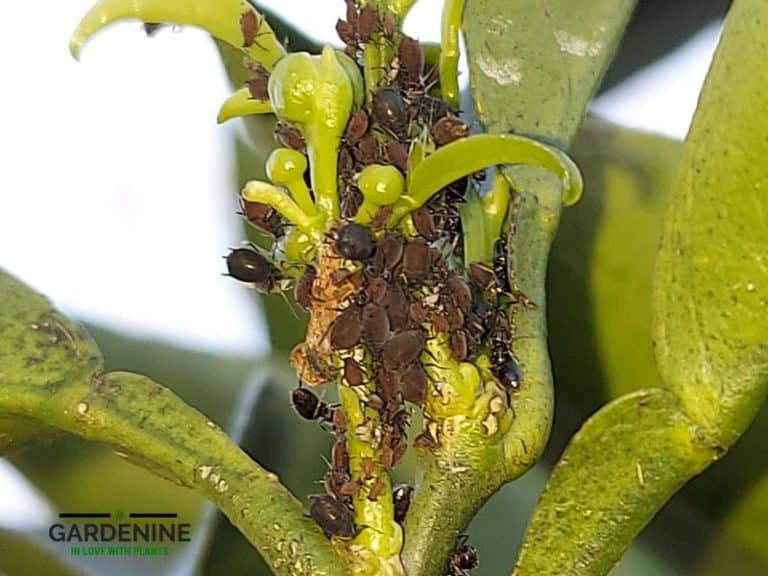Citrus Leaves Curling: Causes + 5 Fixes for Lemon, Orange Trees
Healthy leaves of citrus plants are dark green in color without any blemishes. However, when you see unusual spotting, discoloration, and curling leaves of citrus trees, something is definitely wrong.
Citrus leaf curl is caused by pests, extreme heat or cold, diseases, underwatering, and nutrient deficiency. Aphids, mealy bugs, scales, and mites damage the leaves of citrus trees, making them shrivel and curl. Spray neem oil to kill pests, then maintain a temperature of 60-90°F to stop leaf curl.

Citrus leaves may exhibit different curves depending on the type of citrus tree and the actual cause:
- Leaves curling up: Upward curling is mainly caused by extreme temperature changes. Temperatures above 90 degrees will cause leaf curls in lemon, orange, and lime trees.
- Leaves curling downward indicate potassium deficiency, mainly in lemon and lime trees.
- Leaves curling and turning yellow are signs of nutrient deficiency and pH problems.
Contents:
Causes of citrus leaf curl
Citrus trees are hardy plants and can grow in adverse conditions. Orange trees, lemon, kumquat, and grapefruit trees are quite easy to grow indoors and outdoors.
If the leaves of your trees are curling, the plant is likely to have pests or other problems.
Here are the reasons for curling citrus leaves:
Pests
A common reason for leaf curl in citrus trees is insect infestation (pest attacks). Pests like mealy bugs, aphids, mites, and scale damage foliage and cause wrinkling and curling.
These pests feed on the leaves by sucking the sap directly, causing the leaves to curl and cup downwards.
You can identify pest attacks on lemon, orange, lime, and other citrus trees by checking the underside for pests.
If you see small insects on the underside of leaves, they’re probably the cause of the leaf curl symptoms. Simply apply an insecticidal soap like Bonide’s to get rid of them.
Pests may also cause leaf yellowing and drying when severe.
Nutrient deficiency
Potassium and iron deficiency in citrus trees such as oranges cause symptoms such as yellowing and curling leaves. This problem stems from incorrect soil pH.
Correcting soil pH and applying a good citrus fertilizer that’s low in phosphorus and high in nitrogen is a good start. To fix yellowing and curling, you can also use an iron supplement to feed your lemons, orange, and lime trees.
I’d recommend a foliar nitrogen-rich fertilizer for citrus trees, such as urea, to help improve the health of your lemon, orange, Meyer, and kumquat trees to prevent curling and discoloration.
Extreme cold or heat
Citrus trees such as satsuma and kumquats greatly tolerate extreme temperatures. However, most citrus trees do not do so well in extreme cold or heat and may exhibit leaf curl as a sign of temperature stress.
- Extreme heat in summer dehydrates the plant, forcing the leaves to curl and lose shape due to inadequate water.
- Freezing temperatures in winter cause the leaves of citrus trees to become brittle and deformed.
You can stop the curling by correcting the temperature for indoor citrus trees. Move the plants indoors and maintain the temperature at 60 – 90°F to prevent curling leaves.
Citrus tree diseases

Fungal diseases cause citrus leaves to curl, lose color, wilt, and even drop prematurely. The most common citrus fungal disease that causes curling leaves is bacterial blast.
If your plants already have sap-sucking insects such as aphids, mealybugs, and scales, you may also notice a black fungus that appears as a moldy coating growing on the underside of the leaves of your citrus trees.
This fungus likes to grow and feed on the sticky substance that the insects produce and may contribute to the curling of leaves in lemons and oranges.
Underwatering
The inward curling of leaves is a sign of insufficient water. You might want to check around the base of the tree, whether it is potted or grown in an outside garden, to see if the soil is dry.
Drought will cause leaf curl in citrus trees, only that the leaves do not lose their green color as is common with nutrient deficiencies.
Maintain a good watering routine for your citrus trees, generally watering them when the soil dries out to fix and revive the foliage.
Overwatering
Overwatering can also cause leaves to curl, wilt, and droop in potted citrus plants.
Leaf curl is not the only problem since you may notice discoloration (usually yellowing) and falling.
Other symptoms may occur due to root rot, including stunted growth, dark spots on the stems and leaves, and even plant death.
Treatments for Curling Citrus Leaves
Soil amendment, applying an insecticide, and maintaining a proper cultural care program can help prevent and fix curling leaves in citrus trees.
Here’s how to fix curling leaves in citrus trees:
| Cause of leaf curl | Best fix |
| Pests (aphids, mites) | Spray neem oil to kill pests. |
| Extreme heat or cold | Maintain temp. at 60 – 90°F |
| Bacterial blast | Apply a copper spray. |
| Potassium deficiency | Apply a 10-10-10 fertilizer. |
| Underwatering | Water citrus once every 10 days. |
1. Apply a potassium fertilizer
To treat leaf curl that comes with a yellow discoloration in lemon and orange trees, correct the soil pH to 6.0-7.0 and feed the plants with enough fertilizer – preferably one containing more potassium.
Citrus trees are plants that like coffee grounds. Therefore, a natural way to amend the soil and fix curling leaves in citrus trees is to apply coffee grounds to the soil to improve its pH and also feed the plants with nitrogen, potassium, and phosphorus.
Coffee grounds also help control some fungal diseases in the garden.
Another organic solution instead of synthetic potassium fertilizer is kelp meal made of kelp and seaweed. It is quick-release plant food, so apply it to the soil to improve potassium availability, especially if there’s a deficiency of this nutrient.
2. Maintain a proper watering schedule
A great way to fix the curling leaves in citrus trees is to water mature plants deeply once every 10 days. Allow the soil to dry out between the waterings to avoid overwatering the plant.
- In the summer, provide up to 5 gallons of water per week for potted citrus trees.
- For potted lemon, orange, and lime trees, allow the topmost 2-3 inches of soil to dry out before watering the plant.
I also recommend applying mulch around your citrus trees to prevent excessive water loss from the soil when temperatures are extreme in the summer.
3. Treat citrus tree diseases
Inspect the leaves on your trees to determine if the curling is caused by citrus diseases that I discuss here.
Spots or small patches will usually accompany leaf discoloration and loss of shape due to fungal infections.
Treat fungal infections with a copper spray if it is severe and causing extensive damage. In addition, trim and prune the affected branches to ensure the fungal infection does not spread to other parts of the citrus tree.
4. Treat for pests
Pest infestation is the most common reason for leaf deformation in citrus and other plants. Applying an insecticide can easily kill pests on your indoor and outdoor plants.
- Spray the citrus tree with neem oil or insecticidal soap to help control aphids, mites, and mealy bugs.
- For aphids, introduce predatory insects in your garden, such as ants, to help control the pests.
Video
References
- Government of Western Australia, Department of Agriculture: Aphids in Citrus
- Texas A&M Extension: Understand How Cold Temperatures Affect Citrus Trees


![9 Best Fertilizers for Citrus Trees in 2022 [Organic + Synthetic]](https://gardenine.com/wp-content/uploads/2020/06/Best-Fertilizer-for-Citrus-Trees-organic-and-regular.jpg)

![4 Types of Lime Trees [Varieties, Pictures + Identification]](https://gardenine.com/wp-content/uploads/2020/09/Types-of-Lime-Trees-Key-Limes-fruit.jpg)


